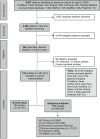Epidemiology of COVID-19: A systematic review and meta-analysis of clinical characteristics, risk factors, and outcomes
- PMID: 32790106
- PMCID: PMC7436673
- DOI: 10.1002/jmv.26424
Epidemiology of COVID-19: A systematic review and meta-analysis of clinical characteristics, risk factors, and outcomes
Abstract
Coronavirus disease 2019 (COVID-19) has become a pandemic, but its reported characteristics and outcomes vary greatly amongst studies. We determined pooled estimates for clinical characteristics and outcomes in COVID-19 patients including subgroups by disease severity (based on World Health Organization Interim Guidance Report or Infectious Disease Society of America/American Thoracic Society criteria) and by country/region. We searched Pubmed, Embase, Scopus, Cochrane, Chinese Medical Journal, and preprint databases from 1 January 2020 to 6 April 2020. Studies of laboratory-confirmed COVID-19 patients with relevant data were included. Two reviewers independently performed study selection and data extraction. From 6007 articles, 212 studies from 11 countries/regions involving 281 461 individuals were analyzed. Overall, mean age was 46.7 years, 51.8% were male, 22.9% had severe disease, and mortality was 5.6%. Underlying immunosuppression, diabetes, and malignancy were most strongly associated with severe COVID-19 (coefficient = 53.9, 23.4, 23.4, respectively, all P < .0007), while older age, male gender, diabetes, and hypertension were also associated with higher mortality (coefficient = 0.05 per year, 5.1, 8.2, 6.99, respectively; P = .006-.0002). Gastrointestinal (nausea, vomiting, abdominal pain) and respiratory symptoms (shortness of breath, chest pain) were associated with severe COVID-19, while pneumonia and end-organ failure were associated with mortality. COVID-19 is associated with a severe disease course in about 23% and mortality in about 6% of infected persons. Individuals with comorbidities and clinical features associated with severity should be monitored closely, and preventive efforts should especially target those with diabetes, malignancy, and immunosuppression.
Keywords: COVID-19; clinical characteristics; mortality; risk factors; severe.
© 2020 Wiley Periodicals LLC.
Conflict of interest statement
Ramsey Cheung has received research support for Gilead Sciences. Mindie H. Nguyen has received research support from Gilead, BMS, and Janssen, and has served as an advisory board member or consultant for Dynavax, Gilead, Alnylam, BMS, Novartis, Spring Bank, and Janssen. Other authors have no disclosures.
Figures


Similar articles
-
Association of pre-existing comorbidities with mortality and disease severity among 167,500 individuals with COVID-19 in Canada: A population-based cohort study.PLoS One. 2021 Oct 5;16(10):e0258154. doi: 10.1371/journal.pone.0258154. eCollection 2021. PLoS One. 2021. PMID: 34610047 Free PMC article.
-
A systematic review and meta-analysis of geographic differences in comorbidities and associated severity and mortality among individuals with COVID-19.Sci Rep. 2021 Apr 20;11(1):8562. doi: 10.1038/s41598-021-88130-w. Sci Rep. 2021. PMID: 33879826 Free PMC article.
-
Global Impact of Coronavirus Disease 2019 Infection Requiring Admission to the ICU: A Systematic Review and Meta-analysis.Chest. 2021 Feb;159(2):524-536. doi: 10.1016/j.chest.2020.10.014. Epub 2020 Oct 15. Chest. 2021. PMID: 33069725 Free PMC article.
-
Association Between Renin-Angiotensin-Aldosterone System Inhibitors and Clinical Outcomes in Patients With COVID-19: A Systematic Review and Meta-analysis.JAMA Netw Open. 2021 Mar 1;4(3):e213594. doi: 10.1001/jamanetworkopen.2021.3594. JAMA Netw Open. 2021. PMID: 33787911 Free PMC article.
-
Comorbidities' potential impacts on severe and non-severe patients with COVID-19: A systematic review and meta-analysis.Medicine (Baltimore). 2021 Mar 26;100(12):e24971. doi: 10.1097/MD.0000000000024971. Medicine (Baltimore). 2021. PMID: 33761654 Free PMC article.
Cited by
-
Risk factors for severe disease in patients admitted with COVID-19 to a hospital in London, England: a retrospective cohort study.Epidemiol Infect. 2020 Oct 13;148:e251. doi: 10.1017/S0950268820002472. Epidemiol Infect. 2020. PMID: 33046155 Free PMC article.
-
SARS-CoV-2 Spike Protein Intensifies Cerebrovascular Complications in Diabetic hACE2 Mice through RAAS and TLR Signaling Activation.Int J Mol Sci. 2023 Nov 16;24(22):16394. doi: 10.3390/ijms242216394. Int J Mol Sci. 2023. PMID: 38003584 Free PMC article.
-
How are Acne Vulgaris Patients Using Oral Isotretinoin Affected by Covid-19?Dermatol Pract Concept. 2022 Jul 1;12(3):e2022146. doi: 10.5826/dpc.1203a146. eCollection 2022 Jul. Dermatol Pract Concept. 2022. PMID: 36159115 Free PMC article.
-
Fourteen-Day Evolution of COVID-19 Symptoms during the Third Wave in Nonvaccinated Subjects and Effects of Hesperidin Therapy: A Randomized, Double-Blinded, Placebo-Controlled Study.Evid Based Complement Alternat Med. 2022 Nov 3;2022:3125662. doi: 10.1155/2022/3125662. eCollection 2022. Evid Based Complement Alternat Med. 2022. PMID: 36387348 Free PMC article.
-
[Obesity, CKD and gender on the 30-day in-hospital mortality risk in adults with COVID-19].Rev Med Inst Mex Seguro Soc. 2022 Aug 31;60(5):540-547. Rev Med Inst Mex Seguro Soc. 2022. PMID: 36048806 Free PMC article. Spanish.
References
Publication types
MeSH terms
LinkOut - more resources
Full Text Sources
Other Literature Sources
Medical
Miscellaneous

